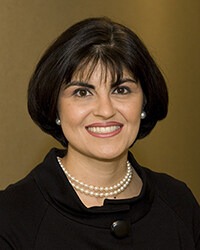AAE-Sponsored Session at ADA 2017
 Dr. Nava Fathi’s ADA 2017 Session Brings Endodontic Competency and Standards to Life
Dr. Nava Fathi’s ADA 2017 Session Brings Endodontic Competency and Standards to Life
As technology and the discipline of endodontics continue to advance, it becomes increasingly important for treatment by all practitioners to meet certain standards.
The AAE recently released a white paper developed to outline and define the requisite skills required by all dentists who perform endodontic diagnosis and treatment. The Endodontic Competency White Paper is a compelling framework supporting a single standard of care.
Helping to bring that framework to life in a persuasive way, Dr. Nava Fathi presented ADA 2017’s AAE-sponsored CE course titled, “Achieving Endodontic Competency and One Standard of Practice,” on Oct. 19 in Atlanta to dozens of general dentists.
The AAE sponsors an education session at the ADA meeting annually as part of its continued outreach to general dentists to help them understand their limitations, partner with an endodontist and get them involved in treatment planning.

"The beauty of this session was the fact that it welcomed questions from the beginning and the audience felt very comfortable asking any question related to the field of endodontics,” Dr. Fathi said. "The questions from the audience ranged from cleaning and shaping questions, to handling endodontic mishaps, to pain management. It was a pleasure to be able to answer the audience's questions about endodontics, from A to Z.”
Dr. Fathi’s presentation covered a lot of ground, including the significant changes in the discipline and technology of endodontics that impact a wide range of endodontic procedures and outcomes. She also described how to manage a patient with pathoses of pulpal and/or periapical origin, how to recognize the potential risk factors that may complicate quality endodontic treatment, and how to determine the degree of difficulty in providing endodontic treatment.
“Sixty-eight percent of root canals are done by you — general dentists,” she told her audience. “So how do you know which ones to treat and not to treat? The AAE has a paper on case assessment difficulty. How do you know if the endo is going to be easy, medium difficulty or really hard?”
No need for endodontists to “hoard” all the cases, Dr. Fathi said, but there has to be education and good communication between the endodontist and the referring general dentist.
“There are plenty of teeth, plenty of root canals,” she continued. “My mentors taught me, the more you educate your general dentists, the better it is for everybody — it’s better for the patient and it’s better for the general dentist, because they can understand and realize the complexities of some of the cases, and they appreciate the fact that you taught them about root canals and they’ll refer the cases if they feel like they cannot do them.”




